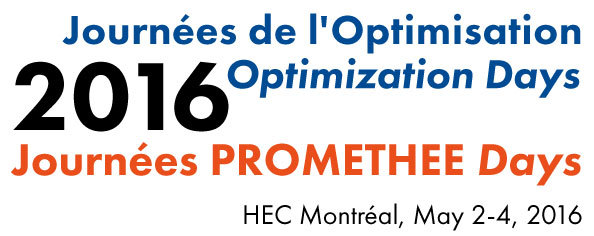
2016 Optimization Days
HEC Montréal, Québec, Canada, 2 — 4 May 2016

TB5 Stochastic Optimization
May 3, 2016 03:30 PM – 05:10 PM
Location: Marie-Husny
Chaired by Claudio Petucco
3 Presentations
-
 03:30 PM - 03:55 PM
03:30 PM - 03:55 PMLand expectation value and optimal rotation age of forest plantations under multiple risks
This study analyses the optimal management for forest plantations under pest and storm disturbances. Using simulations, we analyse different scenarios of pest-outbreak intensities and storm frequencies. We introduce an endogenous rule for deciding, after a storm, whether keeping the standing trees until the rotation end or clear-cutting and replanting.
-
 03:55 PM - 04:20 PM
03:55 PM - 04:20 PMChance-constrained staffing with recourse for multi-skill call centers with arrival rate and absenteeism uncertainty
We consider a chance-constrained two-stage stochastic staffing problem for multi-skill call centers with uncertainty on arrival rate and absenteeism. We first determine an initial staffing based on an imperfect forecast on arrival rate and absenteeism. Then, this staffing is corrected applying recourse actions when the forecast becomes more accurate. We propose a method that combines simulation with integer programming and cut generation to solve the problem.
-
 04:20 PM - 04:45 PM
04:20 PM - 04:45 PMOptimal bidding strategies for an EV fleet operator
In this paper, we address the issue of bidirectional energy transfer between a fleet of electric vehicles and the grid, from the point of view of an operator that plays the twin role of consumer (G2V transfer) and producer (V2G). In this setting, we propose a bilevel programming formulation where the fleet operator (FO), who acts as the leader, sets G2V and V2G profit maximizing price bids. At the lower level, a smart grid (follower) sets quantities transferred to and from the fleet of electric vehicles, with the aim of maximizing social welfare. The bilevel model is then transformed into a mixed integer program that is solved by an off-the-shelf solver. The approach is illustrated by numerical experiments based on the Ontario power grid.
